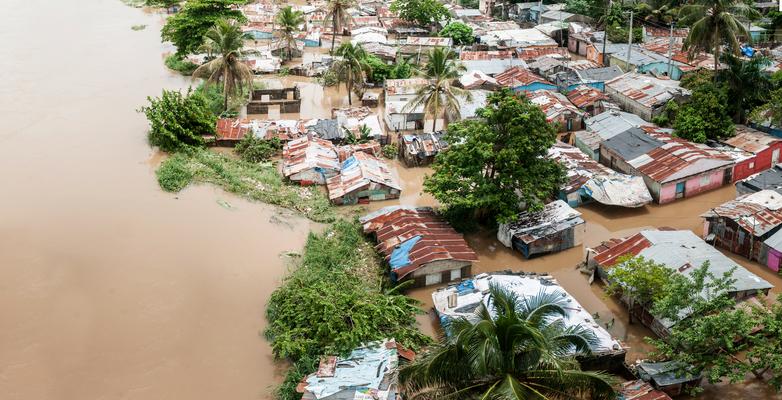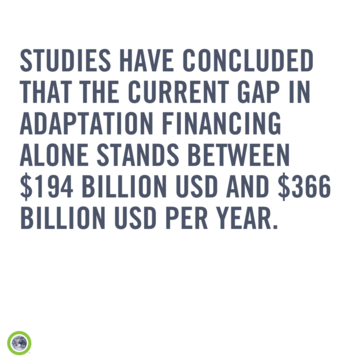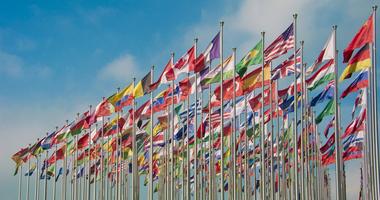
Climate Adaptation Finance and Loss and Damage
6 min read
Despite contributing the least to climate change, the world’s poorest countries are disproportionately burdened by climate impacts like drought, flooding, wildfires, hurricanes, sea level rise, and much more.
Emerging countries, especially those in the Global South, also often lack resources to sufficiently adapt to the climate crisis, which increases the risks of greater economic loss and human suffering. At the same time, historically, the world’s high emitters continue to fall short on providing their fair share of climate finance to help these countries adapt to the changes they’ve largely created.
Adaptation Finance
Climate change adaptation finance is financial support for actions that help communities reduce their vulnerability to the impacts of the climate crisis. This can include measures such as building stronger seawalls to protect coastal communities from flooding, developing drought-tolerant crops to help farmers withstand dry spells, and improving early warning systems to give people more time to prepare for extreme weather events.
Adaptation finance can come from a variety of sources, including public sources, such as development aid from governments, private sources like investments from businesses and individuals, and blended finance, which combines public and private resources.
“Adaptation finance can often be very similar to other types of development finance. This is because support aimed at reducing communities’ economic or social vulnerability will often also have a positive impact on their resilience to climate change,” according to the World Resources Institute. “To be counted as adaptation finance, though, funding should be provided with the express intention of enhancing climate resilience, based on analysis of climate risks.”
Emerging countries are particularly vulnerable to the impacts of climate change, and they need significant financial support to adapt. Current estimates on addressing adaptation financing needs sit at up to $387 billion USD per year until 2030, and it’s no secret that we’ve needed to establish mechanisms to start delivering finance flows to where they are needed most. In 2009, COP 15 in Copenhagen concluded with a commitment of developed countries to mobilize $100 billion USD per year in climate finance to developing countries by 2020. They then extended this commitment through the period 2020-2025. This target has not yet been met – and although it is speculated that it will be met for the first time this year, studies have concluded that the current gap in adaptation financing alone stands between $194 billion USD and $366 billion USD per year.

Adaptation finance is essential to help communities build resilience to climate change and protect people and livelihoods. It is also a sound investment, as it can help to reduce the economic costs of climate change impacts.
Loss and Damage
Climate change loss and damage refers to the irreversible and unavoidable impacts of climate change that are already happening and will continue to happen in the future. This can include physical losses, such as damage to infrastructure, as well as economic losses, such as crop failure and loss of tourism revenue.
Loss and damage, broadly defined, can include the loss of life and property caused by climate change-exacerbated extreme weather events such as hurricanes, floods, and droughts. It can be damage to infrastructure such as roads, bridges, and buildings caused by sea level rise and extreme weather events, or the loss of biodiversity caused by changes in temperature and precipitation patterns. It also includes the displacement of people from their homes due to climate-related disasters and the loss of agricultural productivity caused by droughts and floods.
Loss and damage is a complex and challenging issue, and there is no single definition that is universally accepted. It is a serious threat to human development and well-being. It can lead to displacement, food insecurity, and loss of livelihood. It can also exacerbate existing social and economic inequalities - the world’s poorest and most climate-vulnerable countries have large populations dependent upon activities impacted by climate change, such as agriculture, forestry, and fishing, as well as the least amount of resources available to build back after disaster.
As it is reported that the poorest countries have contributed the least to the climate crisis while being the most heavily impacted by it, the concept of loss and damage is at its core a climate justice issue – and momentum has been building around how to address it.
Loss and Damage at COP
Climate change loss and damage was a major focus at COP 27 in Egypt in November 2022. For the first time, countries agreed to establish a dedicated fund to address the losses and damages caused by climate change in emerging countries. This was a major breakthrough, as it recognized the historical responsibility of developed countries for climate change and the need to provide financial assistance to those countries that are most vulnerable to its impacts.
The decision to establish a loss and damage fund was the result of decades of pressure from developing countries, who have also argued that existing financial mechanisms are not enough to address the full scope of the climate crisis. However, the decision to establish the fund did not come with an immediate influx of monetary pledges by developed countries. Instead, a transitional committee was formed that has been working over the course of the past year to decide how to operationalize the fund – including how it will look, where it will be housed, who will pay into it, where the money will come from, and which countries will benefit.
The upcoming COP 28 in Dubai is set to conclude with answers to these questions, but the current state of play as of the recent fifth transitional committee meeting is that the fund will be housed within the World Bank on an interim basis for four years, with all developing countries allowed to access the fund’s resources.
What You Can Do
Looking to learn more about climate finance? Check out our terms and talking points document to brush up on key definitions and statistics on the state of climate finance, and hear from our branches on our Demystifying Global Climate Finance webinar!
Also, if you’re ready to take the next step, learn more about all the happenings at COP 28 in Dubai by joining Climate Reality for 24 Hours of Reality.
In a year where historic heat waves, wildfires, and floods brought the crisis home to millions, our annual 24 Hours of Reality global media event will take us to the heart of the global response and the UN’s COP 28 climate summit.
Join us on December 7 at 24HoursofReality.org and on our social media channels for an inside look at the voices and the conversations shaping our planet's future.
Streaming live from Dubai, get ready for a day of stories, interviews, and more. You'll be right there with the negotiators deep inside talks and hear from inspiring youth voices, Indigenous leaders, and advocates fighting the fossil fuel agenda.
Along the way, we’ll explore the key issues at COP 28: from phasing out fossil fuels and industry greenwashing to justice for vulnerable countries and the very process of COP itself.
It's a day to share our progress as a movement, the obstacles in our way, and the road to true net zero and a sustainable future for us all. Learn more here.




